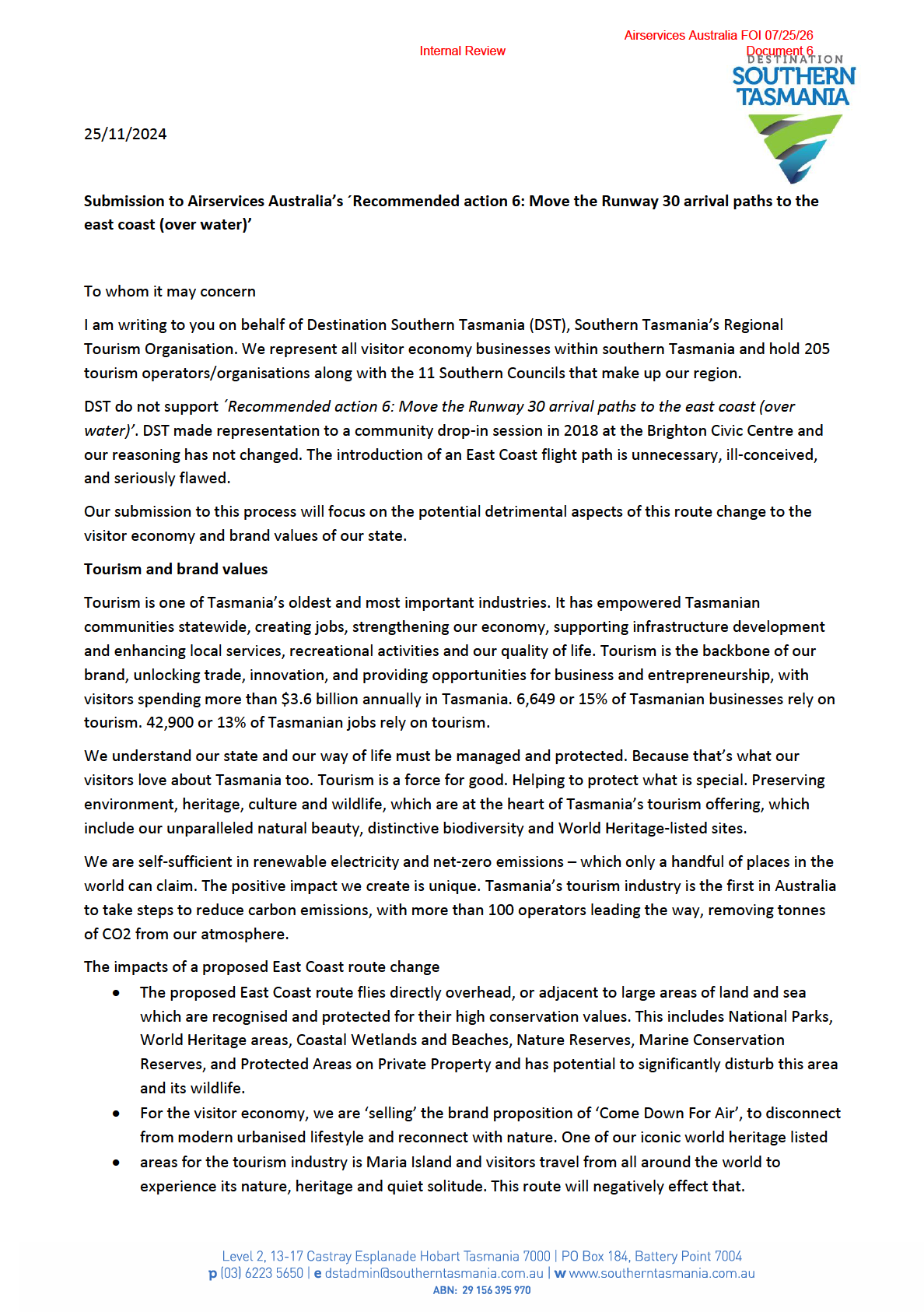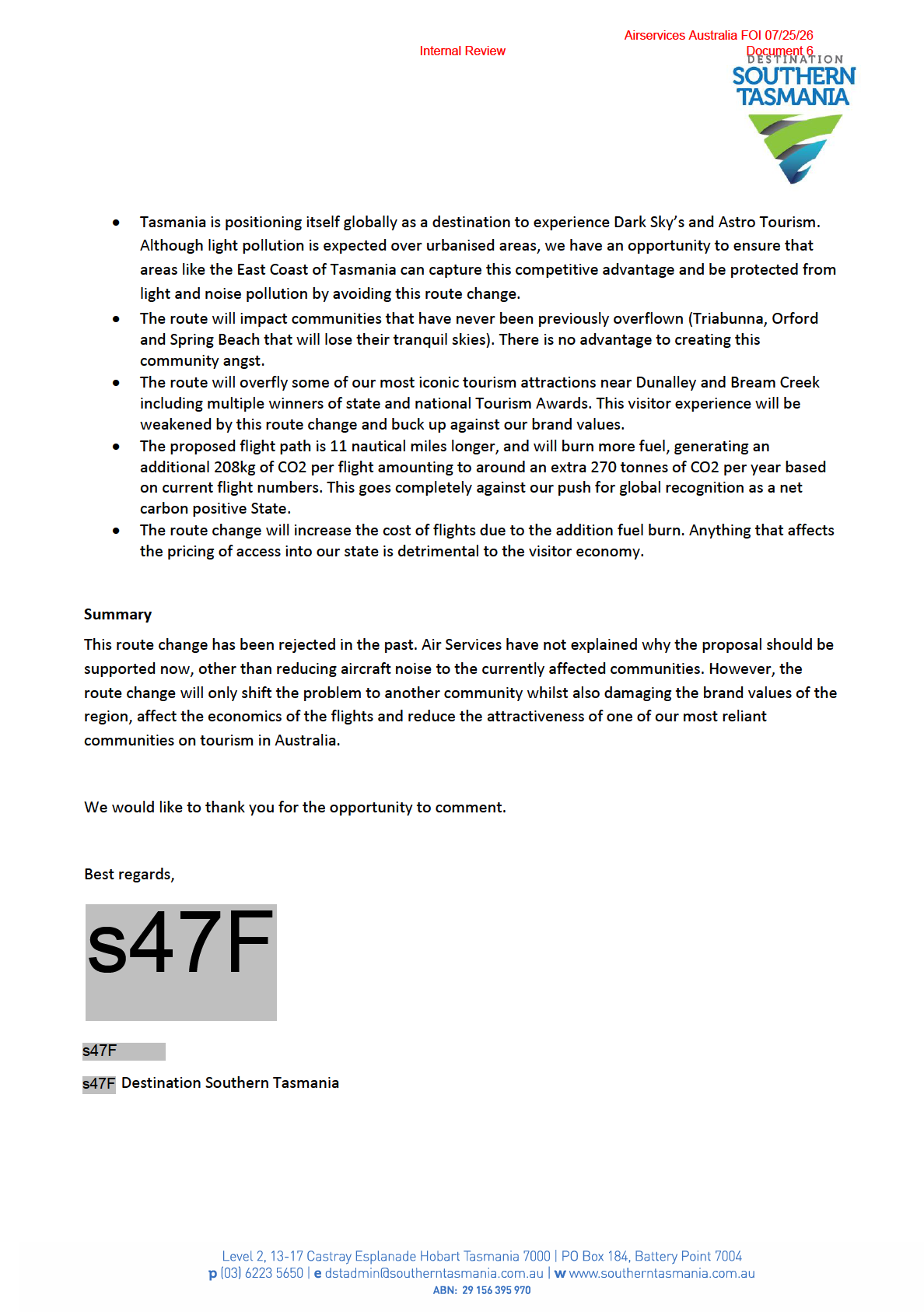OFFICIAL
Airservices Australia FOI 07/25/26
Internal Review
Document 1
Based of ICAO
ICAO Carbon Emissions Calculator Methodology Version 11
B738
From Appendix C: ICAO Fuel Consumption Table
25000
Aircraft
125
250
500
750
1000
1500
2000
2500
3000 Flight Distance (nm)
B738
1715
3494
4621
6221
7749
10666
13460
16170
18818 Fuel Consumption (kg)
Dist 1
Dist 2
change
20000
y = 5.7927x + 1730.4
distance NM
16 NM
19.5 NM
3.5 NM
Fuel Consumption
1823 kg
1843 kg
20 kg
15000
emissions
5.76 tonnes
5.83
0.064 tonnes
ption (kg)
(3.16 tonnes per tonne aviation fuel)
l Consum 10000
Fue
BNE to SYD
500 nm
tonnes per hour
x
5000
0
0
500
1000
1500
2000
2500
3000
3500
Flight Distance (nm)
OFFICIAL
Airservices Australia FOI 07/25/26
Internal Review
Document 1
Existing RNP STAR
Proposed RNP-AR
Existing RNAV
RUMUM to touch
Additional 19.5NM
RUMUM to touch
down (baseline) 16NM (27.92km) 31.3%
down (baseline) 23NM
Track miles
(21.29km)
increase
(21.29km)
CO2 emissions/flight 5760kg/ flight
5830kg/ flight
5890kg/flight
.
OFFICIAL
Airservices Australia IR FOI 07/25/26
Internal Review
Document 2
From:
s47F
To:
s47F
Subject:
RE: Airservices Hobart Airspace Design PIR update for industry
Date:
Tuesday, 3 December 2024 14:58:20
Attachments:
image001.png
image002.png
OFFICIAL
CAUTION: This email was sent from an external email address. Do not click
any links or open any attachments unless you trust the sender and know the
content is safe.
Hi s47F
I missed the cutoff for this as things are hectic here at the moment s47F
s47F
If it is still worth adding, I did some (rough) calculations on Rec#4 for moving the RNP-AR at Hobart. The
proposal states the approach is used on average 15 times per day and the table indicates 3 extra track
miles for the new approach with negligible difference in CO2 emissions. So:
3nm x 15/day x 365 days/yr = 16,425nm extra per year
RNP W RWY30 (AR) for YMHB (7Sep2023) has max IAS 175KT passing HB510, so using
~3nm/minute for that phase of flight => 16,425nm/3nm/min = 5,475mins/yr = ~91hrs/yr extra
flight
At 2500kg fuel burn per hour for a B737 in that phase of flight (sourced from airline), => 2500kg/hr
x 91hrs/yr = 227,500kgs/yr = 227.5t/yr
Using IATA’s conversion rate of 1kg of fuel burn results in 3.16kg of CO2 emission => 227.5t/yr x
3.16CO2/t = ~719t of extra CO2 emissions per year.
So the proposal would result in significant additional total CO2 even using rough calculations, and so
may be beneficial to raise in discussion in a broader environmental forum so that all are aware of the
impact that would have on reaching net-zero CO2.
Regards,
s47F
s47F
OFFICIAL
s22
OFFICIAL
Airservices Australia FOI 07/25/26
Internal Review
Document 3
Proposed option east
Proposed east of
Proposed east coast
Proposed east of of Maria Island to join Maria Island to join
Existing RNP STAR
IPLET route STAR
Maria Island STAR the central arm of the the left arm of the
(Light orange)
(Yellow)
(Green)
RWY30 RNAV STAR
RWY30 RNAV STAR
(White)
(Blue)
78.7
IPLET to touch down Additional 9.52NM
Additional 25.8NM
Additional 30.8NM
Additional 67.89NM
(baseline) 46.80NM
(17.64km) 20.3%
(47.78km) 55.1%
(57.05km) 65.8%
(125.73km) 145.1%
Track miles
(86.67km)
increase
increase
increase
increase
9.52
25.8
30.8
67.89
56.32
72.6
77.6
114.69
Additional 57.1kg CO2 Additional 154.8kg
Additional 184.8kg
Additional 407.4kg
/ flight
additional CO2 / flight CO2 / flight
CO2 / flight
174
472
564
1243
Proposed
Proposed east
CO2 emissions/flight
option east of
Proposed east
of Maria Island
Existing RNP
Proposed east Maria Island to
coast IPLET
to join the left
STAR (Light
of Maria Island join the central
route STAR
arm of the
orange)
STAR (Green)
arm of the
(Yellow)
RWY30 RNAV
RWY30 RNAV
STAR (Blue)
STAR (White)
Additional 19195.2kg
Additional 7082.9kg
Additional 22915.2kg Additional 50510.2kg
IPLET to touch Additional
Additional
Additional
Additional
additional CO2 /
CO2 / month
CO2 / month
CO2 / month
down (baseline) 9.52NM
25.8NM
30.8NM
67.89NM
CO2 emissions/month
month
Track miles
46.80NM
(17.64km)
(47.78km)
(57.05km)
(125.73km)
(86.67km)
20.3% increase 55.1% increase 65.8% increase 145.1% increase
14790
40120
47940
105655
Figures based on 85 RWY 30 RNAV (RNP-Z) arrivals from East Coast for November 2024 using calculations based off ICAO Carbon Emissions Methodology for B738
CO2
Additional
Additional
Additional 174kg Additional 472kg
emissions/flig
564kg CO2 /
1243kg / CO2
57.1
154.8
184.8
407.4
.
CO2 / flight
CO2 / flight
ht
flight
flight
180.436
489.168
583.968
1287.384
7082.9
19195.2
22915.2
50510.2
CO2
Additional
Additional
Additional
Additional
22381.964
60656.832
72412.032
159612.232
emissions/mo
14790kg CO2 / 40120kg CO2 / 47940kg CO2 / 105655kg CO2/
nth
month
month
month
month
Figures based on 85 RWY 30 RNAV (RNP-Z) arrivals from East Coast for November 2024 using calculations based off
ICAO Carbon Emissions Methodology for B738.
OFFICIAL
OFFICIAL
Airservices Australia FOI 07/25/26
Internal Review
Document 3
Proposed option east
Proposed east of
Proposed east coast
Proposed east of
of Maria Island to join Maria Island to join
Existing RNP STAR
IPLET route STAR
Maria Island STAR the central arm of the
the left arm of the
(Light orange)
(Yellow)
(Green)
RWY30 RNAV STAR
RWY30 RNAV STAR
(White)
(Blue)
IPLET to touch down Additional 9.52NM
Additional 25.8NM
Additional 30.8NM
Additional 67.89NM
(baseline) 46.80NM
(17.64km) 20.3%
(47.78km) 55.1%
(57.05km) 65.8%
(125.73km) 145.1%
Track miles
(86.67km)
increase
increase
increase
increase
9.52
25.8
30.8
67.89
Additional 57.1kg CO2 / Additional 154.8kg
Additional 184.8kg
Additional 407.4kg
flight
additional CO2 / flight CO2 / flight
CO2 / flight
CO2 emissions/flight
169.218
458.595
547.47
1206.74475
Additional 19195.2kg
Additional 7082.9kg
Additional 22915.2kg Additional 50510.2kg
additional CO2 /
CO2 / month
CO2 / month
CO2 / month
CO2 emissions/month
month
14383.53
38980.575
46534.95
102573.3038
Figures based on 85 RWY 30 RNAV (RNP-Z) arrivals from East Coast for November 2024 using NP&A Rule of thumb methodology for Medium Jet - cruise 8nm/min
45kg/min*3.16 co2.
57.1
154.8
184.8
407.4
180.436
489.168
583.968
1287.384
7082.9
19195.2
22915.2
50510.2
22381.964
60656.832
72412.032
159612.232
15337.06
41579.28
49637.28
109427.64
OFFICIAL
OFFICIAL
Airservices Australia FOI 07/25/26
Internal Review
Document 3
Based of ICAO
ICAO Carbon Emissions Calculator Methodology Version 11
B738
From Appendix C: ICAO Fuel Consumption Table
25000
Aircraft
125
250
500
750
1000
1500
2000
2500
3000 Flight Distance (nm)
B738
1715
3494
4621
6221
7749
10666
13460
16170
18818 Fuel Consumption (kg)
Dist 1
Dist 2
change
20000
y = 5.7927x + 1730.4
distance NM
36 NM
114.7 NM
78.7 NM
Fuel Consumption
1939 kg
2395 kg
456 kg
15000
emissions
6.1 tonnes
7.6
1.441 tonnes
ption (kg)
(3.16 tonnes per tonne aviation fuel)
l Consum 10000
Fue
BNE to SYD
500 nm
tonnes per hour
x
5000
0
0
500
1000
1500
2000
2500
3000
3500
Flight Distance (nm)
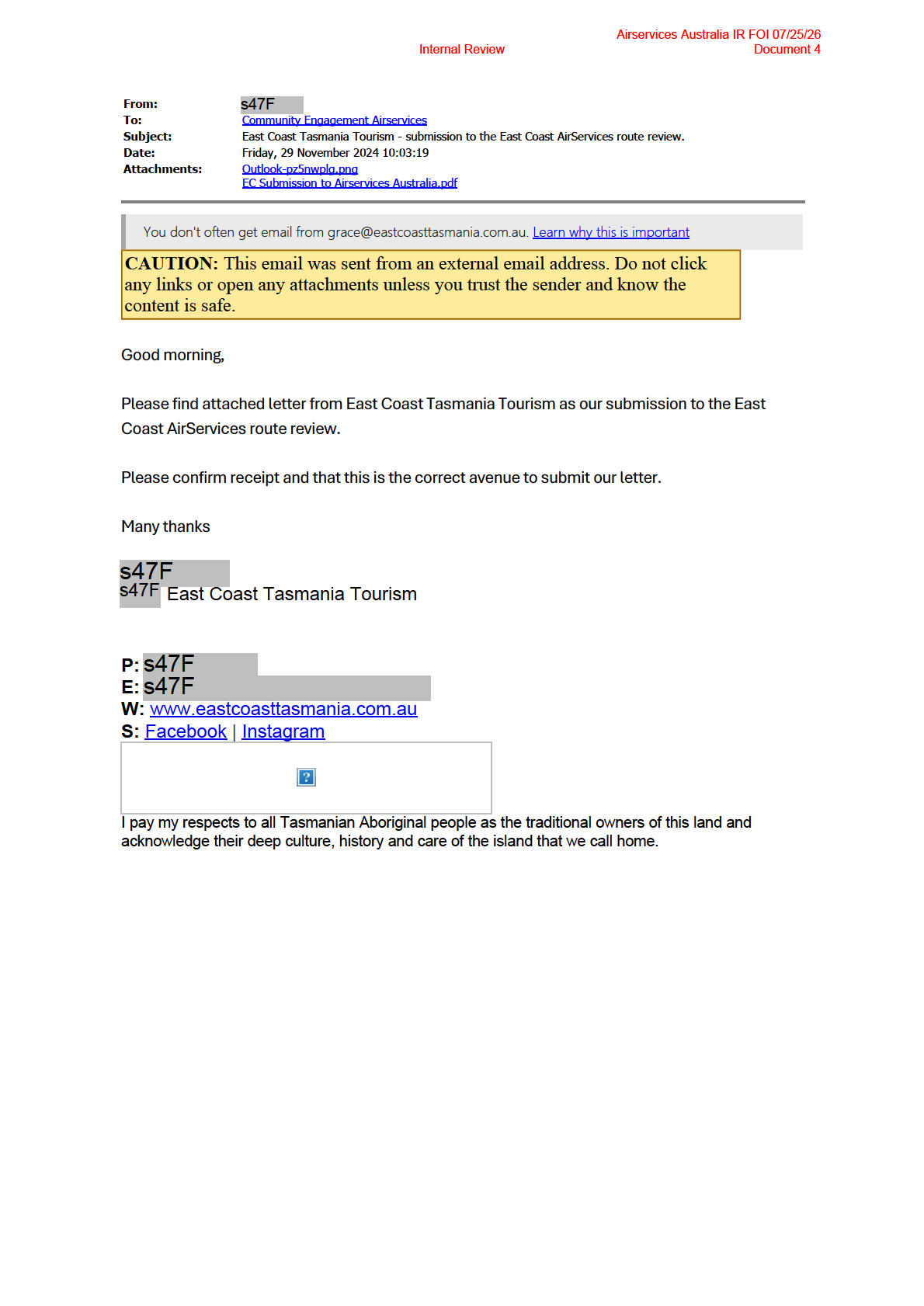
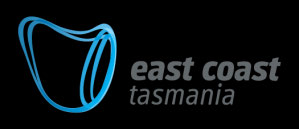
Airservices Australia IR FOI 07/25/26
Internal Review
Document 4
Submission to Airservices Australia’s “Recommended Action 6: Move the Runway 30
Arrival Paths to the East Coast (Over Water)”
To whom it may concern,
I am writing on behalf of East Coast Tasmania Tourism (ECTT), the Regional Tourism
Organisation representing the vibrant visitor economy of Tasmania’s East Coast. Our
organisation works closely with local councils, industry partners, and businesses to promote
and protect the unique identity of our region, which thrives on its pristine environment, natural
beauty, and strong community connections.
ECTT does not support the proposed “Recommended Action 6: Move the Runway 30 arrival
paths to the east coast (over water).” We believe this action threatens the values that underpin
our region’s reputation and prosperity. This submission outlines our concerns and opposes the
proposed flight path change.
The importance of East Coast Tourism
Tourism is the lifeblood of the East Coast, providing significant economic and community
benefits:
• The East Coast attracts thousands of visitors annually, generating critical income for
local businesses, many of which are family-operated.
• Our region is a gateway to iconic destinations, including Maria Island National Park, the
Bay of Fires, and Freycinet Peninsula.
• Tourism sustains our unique lifestyle, supporting employment and creating
opportunities for our communities while preserving our cultural and natural heritage.
• The East Coast Region is the second most dependent region on tourism in Australia and
that economic dependency is predicated on our pristine environment, serenity, and
exclusivity – all of which would be threatened by the proposed change in flight path.
Visitors come to the East Coast to disconnect from urban noise and embrace serenity,
nature, and untouched landscapes. These qualities are fundamental to our appeal and
must be safeguarded to ensure the sector’s long-term viability. One of our points of
difference to the other three regions of Tasmania is that we do not have any major ports and
that the only access to the region is by road or small boat.
1.
Pristine environment and limited human impact:
Unlike other regions with major ports or larger transportation hubs, the East Coast’s lack
of heavy infrastructure means the environment remains largely undisturbed by industrial
activity or high volumes of traffic. Aircraft noise and visual disturbance would represent
a stark intrusion into this otherwise untouched and tranquil setting.
2.
Visitor expectations of solitude and serenity:
Tourists to the East Coast specifically seek a sense of remoteness and peace that is
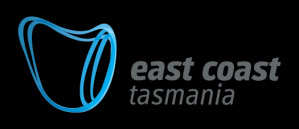
Airservices Australia IR FOI 07/25/26
Internal Review
Document 4
hard to find elsewhere. The absence of major ports underscores this appeal, allowing
visitors to feel truly removed from urban or industrial influences. Introducing aircraft
activity would directly contradict these expectations.
3.
Sustainability and brand integrity:
The region has built its tourism identity around sustainability, with minimal
environmental impact from infrastructure and access methods (roads and small boats).
Aircraft routes would compromise this integrity, undermining the "pristine and
untouched" branding critical to the East Coast's marketability.
4.
Heightened sensitivity to noise and pollution:
Without competing noises from busy ports, large ships, or industrial activity, the East
Coast communities and ecosystems are highly sensitive to new sources of disruption.
Aircraft noise would stand out as particularly intrusive, magnifying its impact on
residents, wildlife, and visitors alike.
5.
Preservation of exclusivity:
The East Coast's exclusivity is rooted in its relative inaccessibility, requiring visitors to
make a deliberate effort to reach the region. This limited access adds to its charm,
offering a sense of discovery and escape. Aircraft routes would erode this sense of
exclusivity, diminishing the special experience associated with visiting the East Coast.
By preserving the East Coast's road-and-small-boat-only access, we ensure that the region
retains its distinctive identity, which is a core competitive advantage in Tasmania’s tourism
landscape. Introducing aircraft routes risks damaging this carefully cultivated balance.
Impacts of the proposed East Coast route change
Environmental concerns
The proposed route would traverse areas of high ecological and conservation value, such as
Maria Island National Park, the Freycinet Peninsula, and nearby marine reserves. These areas
are critical for biodiversity and host several endangered and vulnerable species. Increased
aircraft activity risks disrupting these sensitive ecosystems, undermining conservation efforts
and diminishing the natural experience our region is known for.
Threat to the visitor economy
•
Maria Island and Freycinet: These iconic attractions are renowned for their tranquillity
and natural beauty. Aircraft noise would directly threaten their appeal, particularly for
international and domestic visitors seeking peace and solitude.
•
Emerging astro-tourism: Our region is increasingly recognised as a premier destination
for Dark Sky tourism. Aircraft lights and noise would detract from the pristine night sky
experiences offered in areas like Coles Bay and beyond.
•
Local businesses: The proposed route would directly impact key tourism hubs,
including Triabunna, Orford, and Bicheno, home to operators whose offerings are deeply
intertwined with the region’s peaceful and untouched environment.
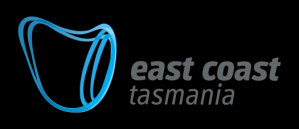
Airservices Australia IR FOI 07/25/26
Internal Review
Document 4
Community impact
Our East Coast communities have long been recognised for their quiet and relaxed lifestyle.
Introducing aircraft noise to previously tranquil areas is an unfair trade-off that shifts problems
from one community to another. This proposal lacks justification and places undue strain on
our region's residents.
Climate and economic contradictions
•
Carbon Emissions: The proposed route is longer, leading to increased fuel
consumption and higher carbon emissions. This contradicts Tasmania’s global
aspirations as a carbon-neutral and environmentally conscious destination.
•
Accessibility and cost: Increased fuel consumption translates to higher operating
costs for airlines, which may ultimately make travel to Tasmania less accessible—
posing a threat to our visitor economy.
Conclusion
The proposed East Coast route change would have profound negative impacts on the East
Coast’s environment, communities, and tourism-dependent economy. By prioritising
convenience for some at the expense of the unique attributes that define our region, this
proposal jeopardises the future sustainability of one of Tasmania’s most cherished
destinations.
We strongly urge Airservices Australia to reject the proposed flight path change and seek
alternative solutions that do not compromise the values and prosperity of Tasmania’s East
Coast.
Thank you for considering our submission. Protecting the serenity, sustainability, and identity of
the East Coast is vital not only for our region but for Tasmania as a whole.
Yours sincerely,
s47F
s47F
s47F
East Coast Tasmania Tourism
s47F
s47F
www.eastcoasttourism.com.au
www.eastcoasttasmania.com.au
Airservices Australia IR FOI 07/25/26
Internal Review
Document 5
From:
s47F
To:
Community Engagement Airservices
Subject:
Tourism Industry Council Tasmania Submission:
Date:
Friday, 29 November 2024 10:36:45
Attachments:
TICT Submission Proposed East Coast Flight Path November 2024.pdf
You don't often get email from xxx.xxxxx@xxxx.xxx.xx. Learn why this is important
CAUTION: This email was sent from an external email address. Do not click
any links or open any attachments unless you trust the sender and know the
content is safe.
Good morning,
Please find the Tourism Industry Council Tasmania's Submission to 'Hobart Community
and Industry Suggested Alternatives' Recommended Action 6.
I am more than happy to be contacted in person for follow up information or a conversation
if you need.
Thank you again for the opportunity to comment.
s47F
s47F Tourism Industry Council Tasmania
Level 5, 29 Elizabeth Street Hobart TAS 7000
s47F
s47F
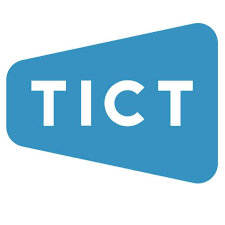
Airservices Australia IR FOI 07/25/26
Internal Review
Document 5
28 November 2024
TICT Submission to Airservices Australia’s Opposing ‘Recommended action 6: Move
runway 30 arrival paths to the east coast (over water)
To whom it may concern,
I am writing to you as the peak industry body for tourism in Tasmania, the Tourism Industry
Council of Tasmania (TICT), which provides a united voice for our industry and is a signatory
to the 2030 Visitor Economy Strategy in partnership with the Tasmanian Government. This
joint governance framework is a unique and enduring partnership which sees industry
partner with Government to plan for the future of our visitor economy, including examining
and proposing appropriate policy frameworks. The Visitor Economy’s contribution to the
broader Tasmanian economy is significant;
• One in eight Tasmanians are employed in the visitor economy – equating to 12% of
all jobs.
• For every dollar spent in the visitor economy, another 83 cents is spent in the
broader Tasmanian economy.
• Tasmania has some of the most heavily reliant regions in the country. For example,
55.3% east coast jobs depend on tourism.
State Tourism Satellite Accounts, 2022-23.
As an island state, access via air is critical to the strength of our visitor economy, however, so
is ensuring this access is coordinated in the most sustainable and low-impact way. As such,
the TICT does not support
‘Recommended Action 6: Move the Runway 30 arrival paths to the
east coast (over water) and encourages that it be rejected on the following grounds;
Impact on newly overflown towns and businesses critical to Tasmania’s visitor economy
The proposed route overflies or is extremely close to important visitor economy demand
driving locations including Triabunna, Orford, Dunalley and Bream Creek. Within these
communities are world class and nationally award-winning tourism operators who have
developed their products and experiences based on the tranquility of the surrounding
environment. Given the role these products and experiences play in acting as a drawcard for
visitors to travel outside the capital city and invest in Tasmania’s regional communities, any
move that could result in reduced visitation and amenity due to newly introduced aircraft
noise would be detrimental to Tasmania’s visitor economy.
Impact on World Heritage sites and iconic natural environments
Maria Island on Tasmania’s East Coast is an iconic location due to its UNESCO World Heritage
listing for the Darlington Convict Station, along with its remote and unique
1
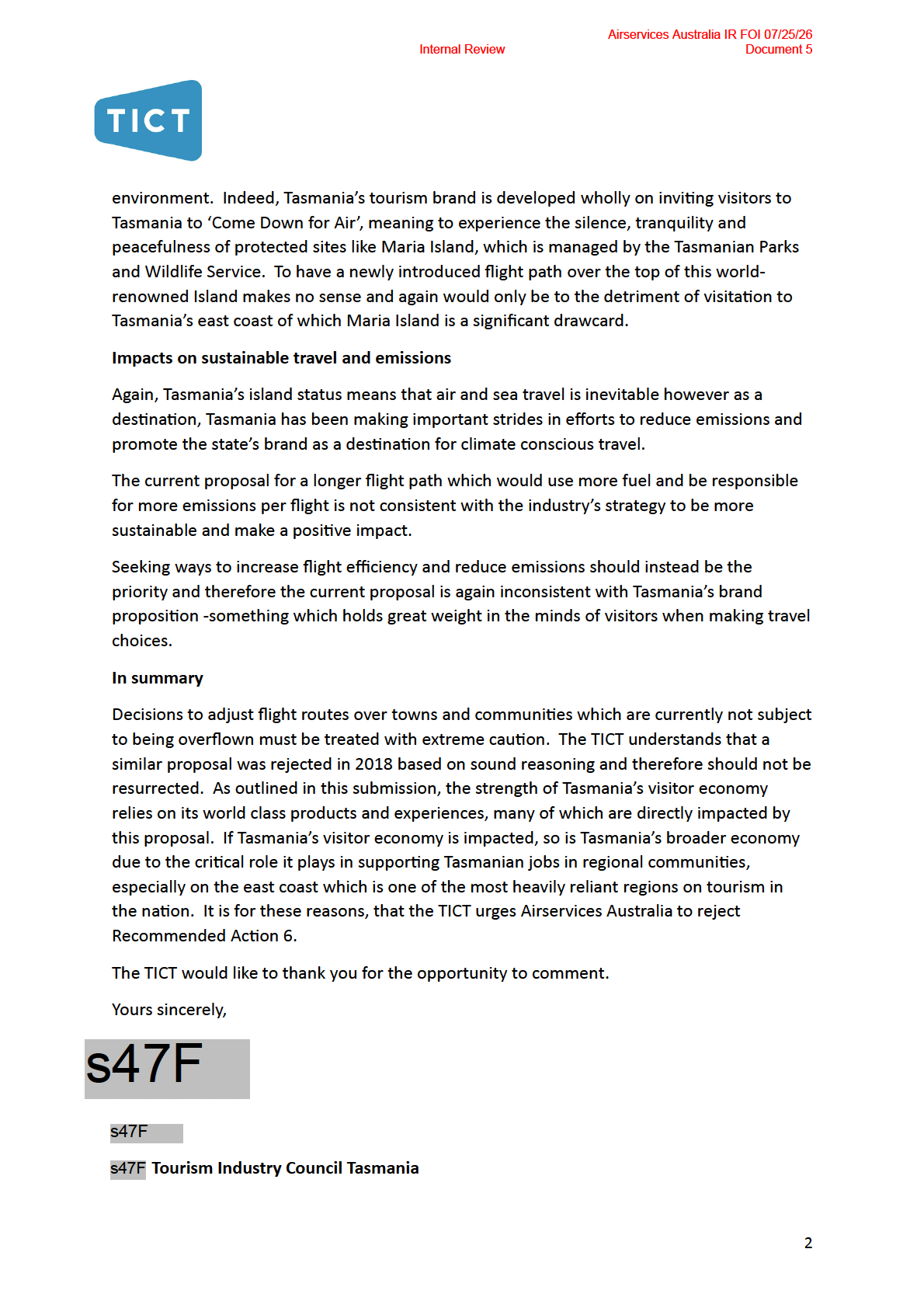

Airservices Australia FOI 07/25/26
Internal Review
Document 6
From:
s47F
To:
Community Engagement Airservices
Cc:
s47F
Subject:
Submission to: Recommended action 6: Move the Runway 30 arrival paths to the east coast (over water)
Tasmania
Date:
Thursday, 28 November 2024 15:37:38
Attachments:
Submission to AirServices East Coast route change 11 24.pdf
CAUTION: This email was sent from an external email address. Do not click
any links or open any attachments unless you trust the sender and know the
content is safe.
To whom it may concern
Thank you for the opportunity to submit to the review. Please find ours attached.
Please also send me an acknowledgement of receipt.
Many thanks
s47F
s47F
s47F
Destination Southern Tasmania
PH: (03) 6223 5650 | MOB: s47F
| E s47F
PO Box 184, BATTERY POINT 7004 | Level 2, 13-17 Castray Esplanade HOBART
We acknowledge and honour the Tasmanian Aboriginal people’s enduring custodianship of
lutruwita/Tasmania for over 40,000 years. As a tourism industry welcoming visitors to
these lands, we aim to represent lutruwita/Tasmania’s history fully, truthfully and
respectfully. We pay our respects to their elders, past and present and their aspirations for
the future of their people and these lands.
